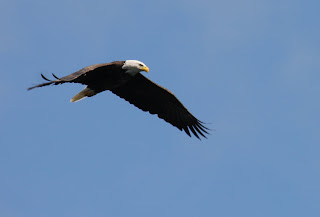 |
| Soaring Bald Eagle |
There’s no question, attempting to photograph flying birds or attempting to catch up with a fleeting antelope is difficult at best. Maybe even impossible. Using your view finder it is hard to anticipate what the flight path of a bird is going to be. Some of us may recall the “sports sight” on some of our older cameras. This was just a wider view of your shooting area, but it went away. Now using a simple BSA Red Dot RD30 scope with the new and improved Xtend-A-Sight Plus you will be able to pick up your subject quicker and follow it for multiple exposures.
Both of these products, the Xtend-A-Site Plus sells for $26.95 retail while the Red Dot RD30 scope varies somewhat pricewise but retails for $26.95. This scope plate slides into your hot shoe on most any camera. After you attach it to the scope, you will only have one piece of equipment to handle.
This unit works very well. However, here are a few techniques to simplify your life.
• Be sure you place the camera strap over your head and brace the camera by holding it out in front of you to steady it. Make sure the strap is pulling against your neck-no slack.
• The “gold standard” for focusing when shooting wildlife has been to set your metering mode (Focus) to a dot or spot metering. I would suggest that you set it to a “center weighted” or evaluative” mode. Here is my reasoning. On your moving subjects, I would suggest aiming for the head as opposed to aiming for the eye.
• I would also suggest that you do not make the focus on your subject so tight that you do not leave enough room to edit and crop.
• Keep in mind that in preparation for shooting f/stop is a critical nuisance as far as a focus is concerned.
• For large animals I’ll typically use Aperture priority at f/5.6 – 8.0. I’ll change that whenever I am shooting birds. Within that range is the sweet spot for my lens, where I can expect reasonably good sharpness. However, when in doubt, shoot Program mode with attention to the ISO and insure the speed is equal (or nearly so) to the stated focal length of the lens.
• I might also suggest you use the #5 position on your scope for the laser intensity. I seem to be able to find it easier than the lower numbers and I just like it better.
• This part is a bit more difficult to explain. The auto focus on most digital cameras has modes; One Shot, Al Focus, and Al Servo. I shot a Canon and this is their terminology. The Nikon cameras refer to these modes as: Single Servo AF [S], Continuous Servo AF [C]. What is going on here is that your lens automatically tracks the subject in the frames, keeping it in focus. I try and keep my camera on the Al Servo focus so that there is one less thing to remember.
a. You may want to use a shutter speed of 1/1000 per second in order to freeze the action.
b. I want my camera programed to AEB (bracketing) and/or Sports mode so that I can shoot continuous multiple images by holding the shutter button down. High Continuous shooting.
c. Follow me here, if you are a shotgun shooter, especially shooting skeet or sporting clays, you’ll know exactly what I am talking about. When you attempt to shoot a moving target, especially a crossing shot. You want to be in a stance ultimately, pointing at where in your swing should intersect your target. In other words a “Sweet spot”. So it is the same with the camera. Point the camera to where the subject currently is and pan ahead to where you think you should begin shooting your photos. Now move your feet (and body) to face this position. This way you will not be all twisted and unstable as you press the shutter release.
d. Be sure to continue to follow your subject and pressing on the shutter button. This is an important step, don’t stop your swing…follow through!
For further information here are the websites; http://www.photosolve.com/
The Red Dot Mounting Sight is http://swfa.comk/BSA-Red-Dot-30mm-Scope-P46653.aspx
# # #
Side Bar: Another item you may want to invest in is a Polaroid Stabilizing Video/Camera Shoulder Mount. This unit fits to your chest making your shoulders and chest the “tripod”. The unit retails for about $50.00 but if you shop you should find it for under $40.00. This unit would definitely create a steadier platform than the camera strap around your neck.
For Information: http://www.polariodstabilizingshouldermount.com/.com

No comments:
Post a Comment